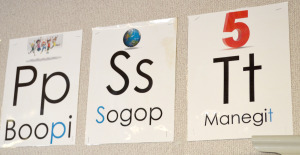EDITOR’S NOTE: We are pleased to announce the addition of reporter Nate Sunderland. He lives in Rexburg and will write about eastern Idaho public education news and features. This is his second installment of a two-part series examining foreign language immersion programs in eastern Idaho. The first installment was from Rigby, where kids are learning Mandarin Chinese and Spanish.
FORT HALL — Foreign language immersion programs across the country are training students to better interact with the world outside the United States.
But at Chief Tahgee Elementary Academy in Fort Hall, foreign language immersion has a more inward-looking purpose. The K-6 charter school is attempting to revive the Shoshoni, and, eventually the Bannock languages among the Shoshone-Bannock tribes.
“A lot of our native language has been lost at this point … and (our languages) are in critical danger because there are so few speakers,” language specialist Merceline Boyer said.
 The loss of the native languages has been most prominent among the young, Boyer said. Many of the tribes’ children were raised speaking English rather than Shoshoni or Bannock.
The loss of the native languages has been most prominent among the young, Boyer said. Many of the tribes’ children were raised speaking English rather than Shoshoni or Bannock.
Once the first language of the Shoshone Indians, Shoshoni has been gradually replaced by English as the tribe’s primary language during the last 50 years. School officials estimate less than 20 percent of tribal members now speak the native language. Fewer still, speak the native Bannock language.
Chief Tahgee Elementary Academy opened in 2013 with the hope of reversing the decline of native speakers.
“This is an effort to retain our lineage and culture starting with our little ones,” Boyer said.
In its first year, only kindergarten students were enrolled in the immersion program. The program was expanded to include first-grade this year. About 45 of the school’s 96 students are now enrolled in the program.

The language immersion is very intensive for the youngest students. With the exception of a 40-minute language arts class, every academic subject is taught in Shoshoni.
Administrators plan to expand the program by one grade each year until the current students get to sixth grade. As the students get older the percentage of English teaching will increase to a 50 percent split by fifth grade.
The goal is for students to be fully literate in both languages.
Most of the curriculum was developed in-house, since there are no ready-made textbooks. Shoshoni originally was a spoken-only language. It has only become a written language during the last 50 years.
Educators use teaching models developed by a Navajo Indian/Spanish/English trilingual immersion school in Flagstaff, Ariz. for curriculum development. They also match curriculum to state standards since students are still required to pass state standardized tests.
Kindergarten teacher Rose Ann Abrahamson said pronounced body language and traditional songs such as “Mary Had a Little Lamb,” have been very effective tools in teaching academic concepts in native languages.
One of the greatest benefits of immersion teaching is the multifaceted perspective it gives the children, Abrahamson said. Shoshoni is a very descriptive language that naturally lends itself to cultural analogy.
“Our students see lessons from numerous angles,” Abrahamson said. “In a (typical) science class you would learn the names of the planets, but here, in our culture we can tell the stories behind the planets. We can look at our environment in multiple ways — from a philosophical, spiritual, academic and scientific perspective.”
Educators say this approach is valuable for young students because the cultural lessons taught alongside the language validate the knowledge students already have. It also helps students understand academic concepts in a context that is more relevant to them.
Abrahamson believes learning native language also improves the self-esteem and self-identification of her students.
First-grader Aiden St. Clair, 7, didn’t grow up in a home with native speaking parents. But after attending Chief Tahgee, his native language and culture have become important to him.
“We are learning because we want to keep our language and because we want to be proud of ourselves,” Aiden said.
He hopes to continue learning at the charter school. Once he leaves elementary school though, Aiden won’t have many academic opportunities to continue exploration of his people’s native languages.
Curriculum Coordinator Cyd Crue said there has been limited interest in pushing native language programs in regional secondary schools so far. But she is optimistic that could change in the future.
“Hopefully, there can be continued efforts after (Chief Tahgee) that can tie in at Sho-Ban High School,” she said. “Learning a second language greatly increases the potential of our students.”
